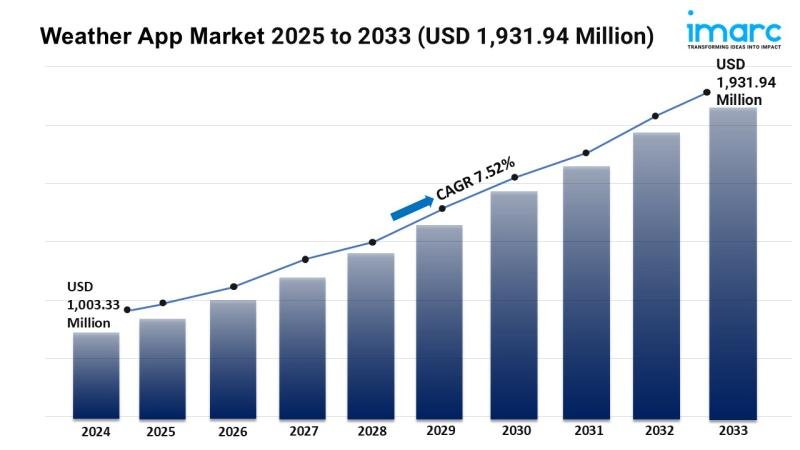Market Overview:
The weather app market is experiencing rapid growth, driven by pervasive smartphone penetration and mobile-first lifestyle, increasing demand for accurate and real-time weather data, and advancements in forecasting technology and data integration. According to IMARC Group’s latest research publication, “Weather App Market Size, Share, Trends and Forecast by Marketplace and Region, 2025-2033”, The global weather app market size was valued at USD 1,003.33 Million in 2024. Looking forward, IMARC Group estimates the market to reach USD 1,931.94 Million by 2033, exhibiting a CAGR of 7.52% during 2025-2033.
This detailed analysis primarily encompasses industry size, business trends, market share, key growth factors, and regional forecasts. The report offers a comprehensive overview and integrates research findings, market assessments, and data from different sources. It also includes pivotal market dynamics like drivers and challenges, while also highlighting growth opportunities, financial insights, technological improvements, emerging trends, and innovations. Besides this, the report provides regional market evaluation, along with a competitive landscape analysis.
Download a sample PDF of this report: https://www.imarcgroup.com/weather-app-market/requestsample
Our report includes:
● Market Dynamics
● Market Trends And Market Outlook
● Competitive Analysis
● Industry Segmentation
● Strategic Recommendations
Growth Factors in the Weather App Market
● Pervasive Smartphone Penetration and Mobile-First Lifestyle:
The widespread adoption of smartphones across diverse demographics globally has undeniably been a colossal growth engine for the weather app market. As smartphones have become an indispensable tool for daily life, providing instant access to information and services, the demand for mobile-first weather solutions has surged. Users no longer rely solely on traditional media like television or radio for weather updates; instead, they expect real-time, on-demand information at their fingertips. This pervasive mobile usage means that individuals frequently consult weather apps for planning their commutes, outdoor activities, travel, and even outfit choices. The convenience and immediacy offered by weather apps on smartphones have cemented their status as essential utilities, driving consistent engagement and fostering a continuous expansion of the user base across all age groups and geographical regions.
● Increasing Demand for Accurate and Real-Time Weather Data:
A critical driver for the growth of weather apps is the escalating user expectation for highly accurate and constantly updated weather information. Modern consumers, spanning individuals, businesses, and various industries, recognize the profound impact weather can have on their daily operations and decision-making. From farmers planning irrigation schedules to logistics companies optimizing delivery routes, precise weather data is paramount. Weather app developers are continually investing in advanced meteorological models, leveraging satellite imagery, radar data, and ground-based sensors to provide hyper-localized forecasts. This commitment to accuracy and the provision of real-time updates through push notifications and interactive maps builds user trust and reliance, ensuring that weather apps remain a go-to source for vital meteorological insights in an increasingly weather-sensitive world.
● Advancements in Forecasting Technology and Data Integration:
The continuous evolution of weather forecasting technology, particularly the integration of Artificial Intelligence (AI) and Machine Learning (ML), is a significant growth factor. These cutting-edge technologies enable weather apps to process vast amounts of complex meteorological data more efficiently, leading to more precise and reliable predictions. AI algorithms can analyze historical weather patterns, identify anomalies, and learn from new observations, constantly refining forecast models. This technological leap allows for the provision of detailed information on microclimates and the anticipation of sudden, localized weather events that were once difficult to predict. Furthermore, the seamless integration of various data sources, including user-contributed observations and data from a multitude of sensors, enhances the richness and granularity of the information available, propelling weather apps into a new era of predictive capability and user value.
Key Trends in the Weather App Market
● Hyper-Personalization and Location-Based Services:
A prominent trend shaping the weather app market is the move towards hyper-personalization and highly precise location-based services. Users are no longer satisfied with general regional forecasts; they demand weather information tailored to their exact street address or even specific points of interest. Modern weather apps are increasingly leveraging advanced GPS capabilities and intricate mapping technologies to deliver hyper-local updates, often down to the minute. This trend extends beyond just displaying temperature and precipitation; it includes personalized alerts for specific activities like pollen counts for allergy sufferers, wind conditions for outdoor sports, or UV indexes for sun protection. This granular level of detail, combined with customized notification settings and user-specific recommendations, fosters a deeper connection with users, making the app an indispensable personal weather assistant rather than a generic information source.
● Integration with Smart Home Devices and the Internet of Things (IoT):
The growing ecosystem of smart home devices and the broader Internet of Things (IoT) presents a significant trend and opportunity for weather app integration. As more homes become connected, there’s a natural synergy between weather data and automated home functionalities. For instance, smart thermostats can adjust heating or cooling based on anticipated temperature changes from a weather app, optimizing energy consumption. Similarly, smart irrigation systems can factor in rainfall predictions to avoid overwatering, and smart blinds can automatically close to mitigate excessive sunlight. This seamless integration allows weather information to become actionable, moving beyond mere display to actively influencing daily comfort, efficiency, and resource management within smart environments. This trend is set to expand as IoT devices become more ubiquitous, creating new avenues for weather apps to enhance user convenience and intelligent automation.
● Diversified Monetization Strategies and Premium Features:
As the weather app market matures, a key trend is the diversification of monetization strategies beyond traditional advertising models, with a strong emphasis on premium features. While many apps continue to offer a free, ad-supported version, there’s a growing inclination towards subscription-based models or in-app purchases that unlock enhanced functionalities. These premium offerings often include ad-free experiences, hyper-local radar, advanced forecast models, historical weather data, severe weather alerts delivered faster, or even exclusive widgets and customization options. For example, some apps offer premium tiers tailored to specific needs, such as detailed agricultural forecasts for farmers or specialized wind data for sailors. This shift allows developers to generate more stable and predictable revenue streams while catering to users who seek a more comprehensive, uninterrupted, and tailored weather experience, ensuring the long-term sustainability and innovation within the market.
Buy Full Report: https://www.imarcgroup.com/checkout?id=8568&method=1670
Leading Companies Operating in the Global Weather App Industry:
● AccuWeather Inc.
● Acme AtronOmatic LLC
● Apalon LLC
● CARROT Weather
● DTN
● IBM Corporation
Weather App Market Report Segmentation:
By Marketplace:
● Google Play Store
● Apple iOS Store
● Others
Google play store represents the largest segment as it provides an incredibly broad market reach, accessible to users across the globe.
Regional Insights:
● North America (United States, Canada)
● Asia Pacific (China, Japan, India, South Korea, Australia, Indonesia, Others)
● Europe (Germany, France, United Kingdom, Italy, Spain, Russia, Others)
● Latin America (Brazil, Mexico, Others)
● Middle East and Africa
North America’s dominance in the market is attributed to the rising adoption of weather apps to gain insights about air quality and ultraviolet (UV) index.
Ask Analyst for Sample Report: https://www.imarcgroup.com/request?type=report&id=8568&flag=C
Research Methodology:
The report employs a comprehensive research methodology, combining primary and secondary data sources to validate findings. It includes market assessments, surveys, expert opinions, and data triangulation techniques to ensure accuracy and reliability.
Note: If you require specific details, data, or insights that are not currently included in the scope of this report, we are happy to accommodate your request. As part of our customization service, we will gather and provide the additional information you need, tailored to your specific requirements. Please let us know your exact needs, and we will ensure the report is updated accordingly to meet your expectations.
About Us:
IMARC Group is a global management consulting firm that helps the world’s most ambitious changemakers to create a lasting impact. The company provide a comprehensive suite of market entry and expansion services. IMARC offerings include thorough market assessment, feasibility studies, company incorporation assistance, factory setup support, regulatory approvals and licensing navigation, branding, marketing and sales strategies, competitive landscape and benchmarking analyses, pricing and cost research, and procurement research.
Contact Us:
IMARC Group
134 N 4th St. Brooklyn, NY 11249, USA
Email: sales@imarcgroup.com
Tel No:(D) +91 120 433 0800
United States: +1-631-791-1145
This release was published on openPR.















